An Experimental Investigation on Flame Pulsation for a Swirl Non-Premixed Combustion
Abstract
:1. Introduction
2. Experimental Setup
2.1. Experimental Apparatus
- (1)
- An air compressor and a high-pressure gas holder are the main components of the supply section. A mass flow rate controller (MFC) measures and controls the flow rate of fuel (methane) coming from the gas holder. MFC’s maximum flow rate capacity is 36 g/min. The air compressor supplies the combustion air at a maximum of 2.5 kg/min flow rate. An electric control valve (not shown in Figure) regulates the air flow, and an air flow meter measures the flow rate.
- (2)
- Second, there is combustion section consisting of a combustor and swirl burner. As shown in Figure 2, the combustor is 1.35 m long cylindrical chamber which is axisymmetric and have 0.3 m diameter. The Swirl burner consists of a radial swirler, central fuel tube, and convergent-divergent passing. The swirler improves the mixing quality of fuel and air. It has 10 straight vanes having a setting angle α of 50°. The convergent-divergent nozzle is designed to enhancing flame stability. The angle between the vertical line and the nozzle’s divergent side face is 42°. A fraction of air (primary air) tangentially flows through the radial swirler and carries fuel supplied by the central fuel tube into combustion chamber, where combustion occurs. On a mass basis, primary air is only 5% of the total air supplied. The primary air premixes the fuel in the burner sector before combustion and controls the flame length. The level of mixing between fuel and primary air is still insufficient as the mixing occurs in a shorter distance. The remaining/surplus air (secondary air) flows into the annular slot through a wind distributing plate and then enters the combustor flowing adjacent to the inner wall. Secondary air supports combustion and cools the wall to avert damage to the metallic parts caused by overheating. To observe and record the flame structure, a window (which is optically accessible) is attached to the combustor wall.
- (3)
- Finally, there is exhaust section comprised of a pressure regulating valve and induced draught system. The former controls the combustor operating pressure, while the latter draws exhaust gas out to the atmosphere.
2.2. Measurement Methods
2.3. Experimental Conditions
3. Results and Discussion
3.1. Flame Dynamics
3.2. Frequency and Amplitude versus Fuel Mass Flow Rate
3.3. Frequency and Amplitude versus Combustor Pressure
3.4. Frequency and Amplitude versus Primary Air Mass Flow Rate
3.5. Frequency and Amplitude versus Injector Exit Velocity
3.6. Predicted Frequencies and Correlations
4. Conclusions
- (1)
- Flame pulsation was caused by the upward movement of large toroidal vortices, which were driven by buoyancy induced by combustion. Some interesting oscillating phenomena during the puffing process were observed, including the flame’s auto-ignition at the flame base, the variation in flame lift-off height, flame extinction at the flame tip, and the formation of some isolated small burning regions. These behaviors provided more insights into the understanding of flame puffing.
- (2)
- As fuel mass flow rate ṁF increased, the puffing frequency amplified due to the increased flame temperature caused by the decreased flame radiation fraction. The puffing amplitude became smaller with the increase in ṁF, which implied the flame oscillating became more stable at higher ṁF.
- (3)
- As combustor pressure P increased, the flickering frequency declined because of the decreased flame temperature induced by the increasing soot radiation. The flickering amplitude uniformly increased with the increment of P, which indicated that flame oscillations were deteriorated under higher P.
- (4)
- As the primary air mass flow rate ṁpri increased, the puffing frequency decreased due to the reduced flame temperature resulted from the enhanced mixing between fuel and primary air. The puffing amplitude varied non-monotonously with an increase in ṁpri, which suggested that the intensity of flame pulsation had an oscillating relationship with ṁpri.
- (5)
- As the injector exit velocity ve increased, the flickering frequency diminished almost linearly because of the dropped flame temperature caused by the improved swirl intensity. The flickering amplitude remained approximately unchanged with an increment in ve, which indicated the flame oscillation strength was almost unaffected by ve.
- (6)
- The obtained puffing frequencies of the current measurement for all cases varied within the range of 3–22 Hz, the predicted values from all theoretical models fall within this range. The puffing frequency of swirl burning was more sensitive to the variation in operating conditions than that of non-swirl burning. The obtained correlations indicated St was proportional to Fr−1.4 and Re−2.9, respectively.
Author Contributions
Funding
Conflicts of Interest
References
- Malalasekera, W.M.G.; Versteeg, H.K.; Gilchrist, K. A Review of Research and an Experimental Study on the Pulsation of Buoyant Diffusion Flames and Pool Fires. Fire Mater. 1996, 20, 261–271. [Google Scholar] [CrossRef]
- Pan, K.L.; Li, C.C.; Juan, W.C.; Yang, J.T. Low-frequency oscillation of a non-premixed flame on a bluff-body burner. Combust. Sci. Technol. 2009, 181, 1217–1230. [Google Scholar] [CrossRef]
- Sahu, K.B.; Kundu, A.; Ganguly, R.; Datta, A. Effects of fuel type and equivalence ratios on the flickering of triple flames. Combust. Flame 2009, 156, 484–493. [Google Scholar] [CrossRef]
- Bahadori, M.Y.; Zhou, L.; Stocker, D.P.; Hegde, U. Functional Dependence of Flame Flicker on Gravitational Level. AIAA J. 2001, 39, 1404–1406. [Google Scholar] [CrossRef]
- Durox, D.; Yuan, T.; Villermaux, E. The Effect of Buoyancy on Flickering in Diffusion Flames. Combust. Sci. Technol. 1997, 124, 277–294. [Google Scholar] [CrossRef]
- Arai, M.; Sato, H.; Amagai, K. Gravity effects on stability and flickering motion of diffusion flames. Combust. Flame 1999, 118, 293–300. [Google Scholar] [CrossRef]
- Hamins, A.; Yang, J.C.; Kashiwagi, T. An experimental investigation of the pulsation frequency of flames. Symp. Combust. 1992, 24, 1695–1702. [Google Scholar] [CrossRef]
- Cetegen, B.M.; Kasper, K.D. Experiments on the oscillatory behavior of buoyant plumes of helium and helium-air mixtures. Phys. Fluids 1996, 8, 2974–2984. [Google Scholar] [CrossRef]
- Bejan, A. Predicting the pool fire vortex shedding frequency. J. Heat Transf. 1991, 113, 261. [Google Scholar] [CrossRef]
- Pagni, P.J. Pool vortex shedding frequencies. Appl. Mech. Rev. 1990, 43, 160. [Google Scholar]
- Yilmaz, N.; Lucero, R.E.; Donaldson, A.B.; Gill, W. Flow characterization of diffusion flame oscillations using particle image velocimetry. Exp. Fluids 2009, 46, 737–746. [Google Scholar] [CrossRef]
- Yilmaz, N.; Burl Donaldson, A.; Edward Lucero, R. Experimental study of diffusion flame oscillations and empirical correlations. Energy Convers. Manag. 2008, 49, 3287–3291. [Google Scholar] [CrossRef]
- Tang, F.; Hu, L.; Wang, Q.; Ding, Z. Flame pulsation frequency of conduction-controlled rectangular hydrocarbon pool fires of different aspect ratios in a sub-atmospheric pressure. Int. J. Heat Mass Transf. 2014, 76, 447–451. [Google Scholar] [CrossRef]
- Gotoda, H.; Kawaguchi, S.; Saso, Y. Experiments on dynamical motion of buoyancy-induced flame instability under different oxygen concentration in ambient gas. Exp. Therm. Fluid Sci. 2008, 32, 1759–1765. [Google Scholar] [CrossRef]
- Fang, J.; Tu, R.; Guan, J.F.; Wang, J.J.; Zhang, Y.M. Influence of low air pressure on combustion characteristics and flame pulsation frequency of pool fires. Fuel 2011, 90, 2760–2766. [Google Scholar] [CrossRef]
- Wang, Q.; Hu, L.; Tang, F.; Zhang, X.; Delichatsios, M. Characterization and comparison of flame fluctuation range of a turbulent buoyant jet diffusion flame under reduced- and normal pressure atmosphere. Procedia Eng. 2013, 62, 211–218. [Google Scholar] [CrossRef]
- Tao, C.F.; Cai, X.S.; Wang, X. Experimental Determination of Atmospheric Pressures Effects on Flames from Small Scale Pool Fires. J. Fire Sci. 2013, 31, 387–394. [Google Scholar] [CrossRef]
- Pretrel, H.; Audouin, L. Periodic puffing instabilities of buoyant large-scale pool fires in a confined compartment. J. Fire Sci. 2013, 31, 197–210. [Google Scholar] [CrossRef]
- Chen, X.; Lu, S.; Wang, X.; Liew, K.M.; Li, C.; Zhang, J. Pulsation Behavior of Pool Fires in a Confined Compartment with a Horizontal Opening. Fire Technol. 2016, 52, 515–531. [Google Scholar] [CrossRef]
- Chen, X.; Lu, S.X. On the Analysis of Flame Pulsation and Fire Induced Vent Flow Oscillatory Behaviors in Confined Enclosures with Horizontal Openings. Procedia Eng. 2018, 211, 104–112. [Google Scholar] [CrossRef]
- Chen, J.; Bao, Q. Digital image processing based fire flame color and oscillation frequency analysis. Procedia Eng. 2012, 45, 595–601. [Google Scholar] [CrossRef]
- Domkundwar, V.M.; Sriramulu, V.; Gupta, M.C. Analysis of swirling recirculating reacting turbulent jets passing through diffusers. Combust. Flame 1978, 33, 241–249. [Google Scholar] [CrossRef]
- Cheng, T.S.; Chao, Y.C.; Wu, D.C.; Yuan, T.; Lu, C.C.; Cheng, C.K.; Chang, J.M. Effects of fuel-air mixing on flame structures and NOxemissions in swirling methane jet flames. Symp. Combust. 1998, 27, 1229–1237. [Google Scholar] [CrossRef]
- Terasaki, T.; Hayashi, S. The effects of fuel-air mixing on NOxformation in non-premixed swirl burners. Symp. Combust. 1996, 26, 2733–2739. [Google Scholar] [CrossRef]
- Boyce, M.P. Theoretical and Actual Cycle Analyses. In Gas Turbine Engineering Handbook; Elsevier: Waltham, MA, USA, 2012; p. 90. ISBN 9780123838421. [Google Scholar]
- Gomez-Ramirez, D.; Kedukodi, S.; Gadiraju, S.; Ekkad, S.V.; Moon, H.-K.; Kim, Y.; Srinivasan, R. Gas turbine combustor rig development and initial observations at cold and reacting flow conditions. In Proceedings of the ASME Turbo Expo: Turbomachinery Technical Conference and Exposition, Seoul, Korea, 13–17 June 2016. [Google Scholar]
- Lefebvre, A.H.; Ballal, D.R. Emissions. In Gas Turbine Combustion: Alternative Fuels and Emissions; CRC Press: Boca Raton, FL, USA, 2010; pp. 366–382. ISBN 9781420086058. [Google Scholar]
- Turns, S. Laminar diffusion flames. In An Introduction to Combustion: Concepts and Applications; McGraw-Hill: Columbus, OH, USA, 2000; pp. 338–340. [Google Scholar]
- Li, M.; Tong, Y.; Klingmann, J.; Thern, M. Impact of vitiation on a swirl-stabilized and premixed methane flame. Energies 2017, 10, 1557. [Google Scholar] [CrossRef]
- Samaniego, J.-M.; Egolfopoulos, F.N.; Bowman, C.T. CO2* Chemiluminescence in Premixed Flames. Combust. Sci. Technol. 1995, 109, 183–203. [Google Scholar] [CrossRef]
- Lee, J.G.; Santavicca, D.A. Experimental Diagnostics for the Study of Combustion Instabilities in Lean Premixed Combustors. J. Propuls. Power 2003, 19, 735–750. [Google Scholar] [CrossRef]
- Tachibana, S.; Kanai, K.; Yoshida, S.; Suzuki, K.; Sato, T. Combined effect of spatial and temporal variations of equivalence ratio on combustion instability in a low-swirl combustor. Proc. Combust. Inst. 2015, 35, 3299–3308. [Google Scholar] [CrossRef]
- Yoon, J.; Kim, M.K.; Hwang, J.; Lee, J.; Yoon, Y. Effect of fuel-air mixture velocity on combustion instability of a model gas turbine combustor. Appl. Therm. Eng. 2013, 54, 92–101. [Google Scholar] [CrossRef]
- Meier, W.; Weigand, P.; Duan, X.R.; Giezendanner-Thoben, R. Detailed characterization of the dynamics of thermoacoustic pulsations in a lean premixed swirl flame. Combust. Flame 2007, 150, 2–26. [Google Scholar] [CrossRef]
- Turns, S.R. Turbulent Nonpremixed Flames. In An Introduction to Combustion: Concepts and Applicationsan Introduction to Combustion: Concepts and Applications; McGraw-Hill: Columbus, OH, USA, 2000; pp. 501–502. ISBN 9780124974517. [Google Scholar]
- Viskanta, R.; Menguc, M.P. Radiation heat transfer in combustion systems. Prog. Energy Combust. Sci. 1987, 13, 97–160. [Google Scholar] [CrossRef]
- Lefebvre, A.H. Flame radiation in gas turbine combustion chambers. Int. J. Heat Mass Transf. 1984, 27, 1493–1510. [Google Scholar] [CrossRef]
- Claus, R.W. Spectral Flame Radiance from a Tubular-Can Combustor; NASA Lewis Research Center: Cleveland, OH, USA, 1981. [Google Scholar]
- Law, C.K. Chemical Thermodynamics. In Combustion Physics; Cambridge University Press: New York, NY, USA, 2006; p. 41. ISBN 9780511754517. [Google Scholar]
- Sheen, H.J.; Chen, W.J.; Jeng, S.Y.; Huang, T.L. Correlation of Swirl Number for a Radial-Type Swirl Generator. Exp. Therm. Fluid Sci. 1996, 12, 444–451. [Google Scholar] [CrossRef]
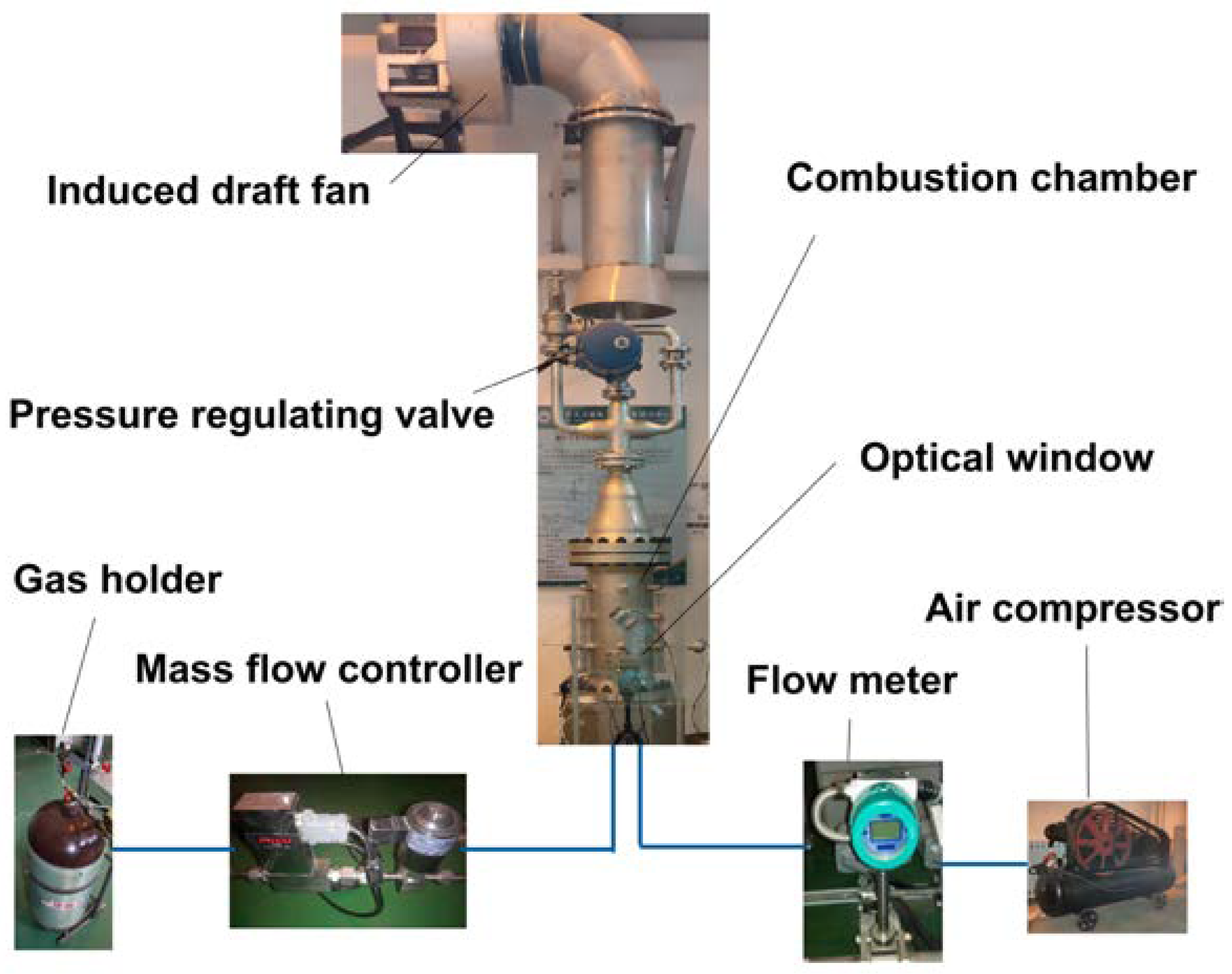
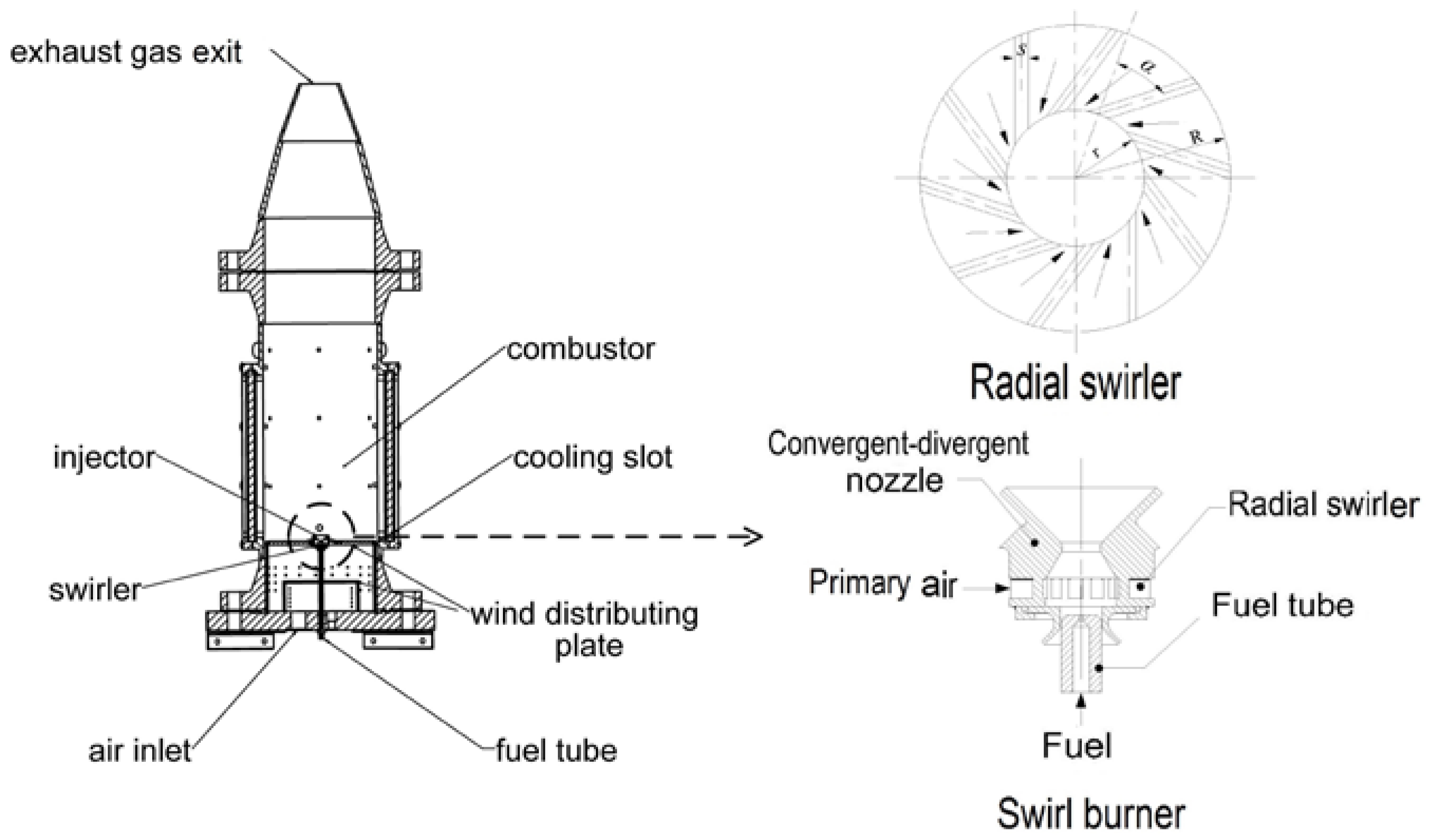
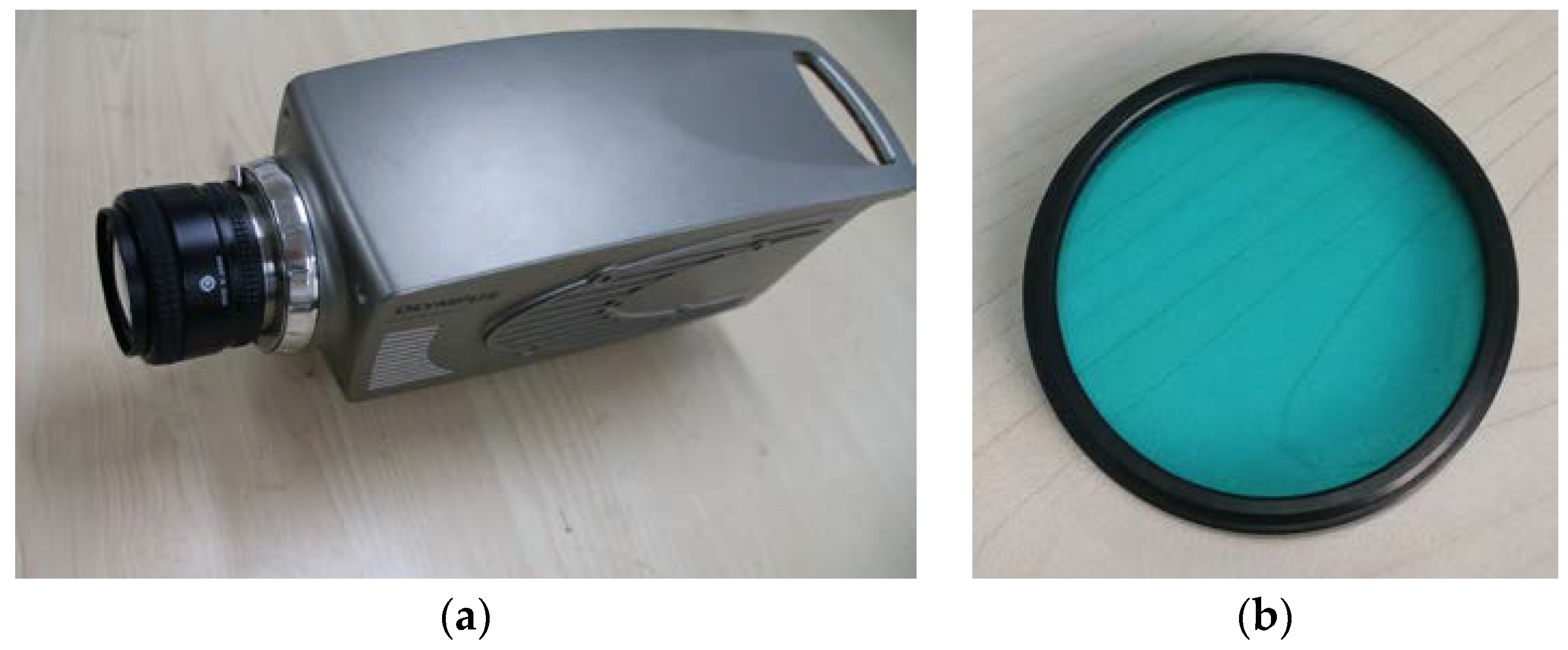

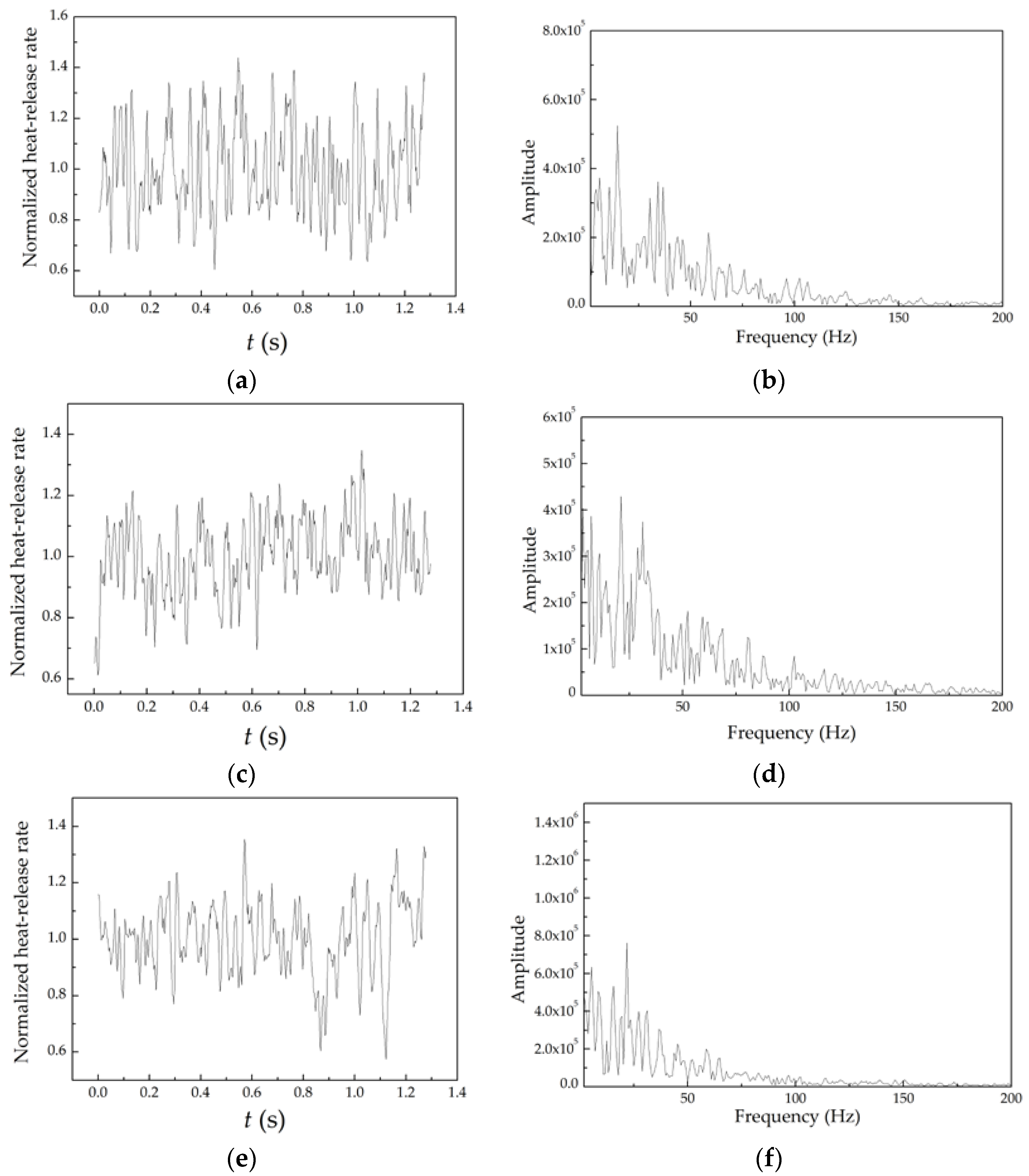
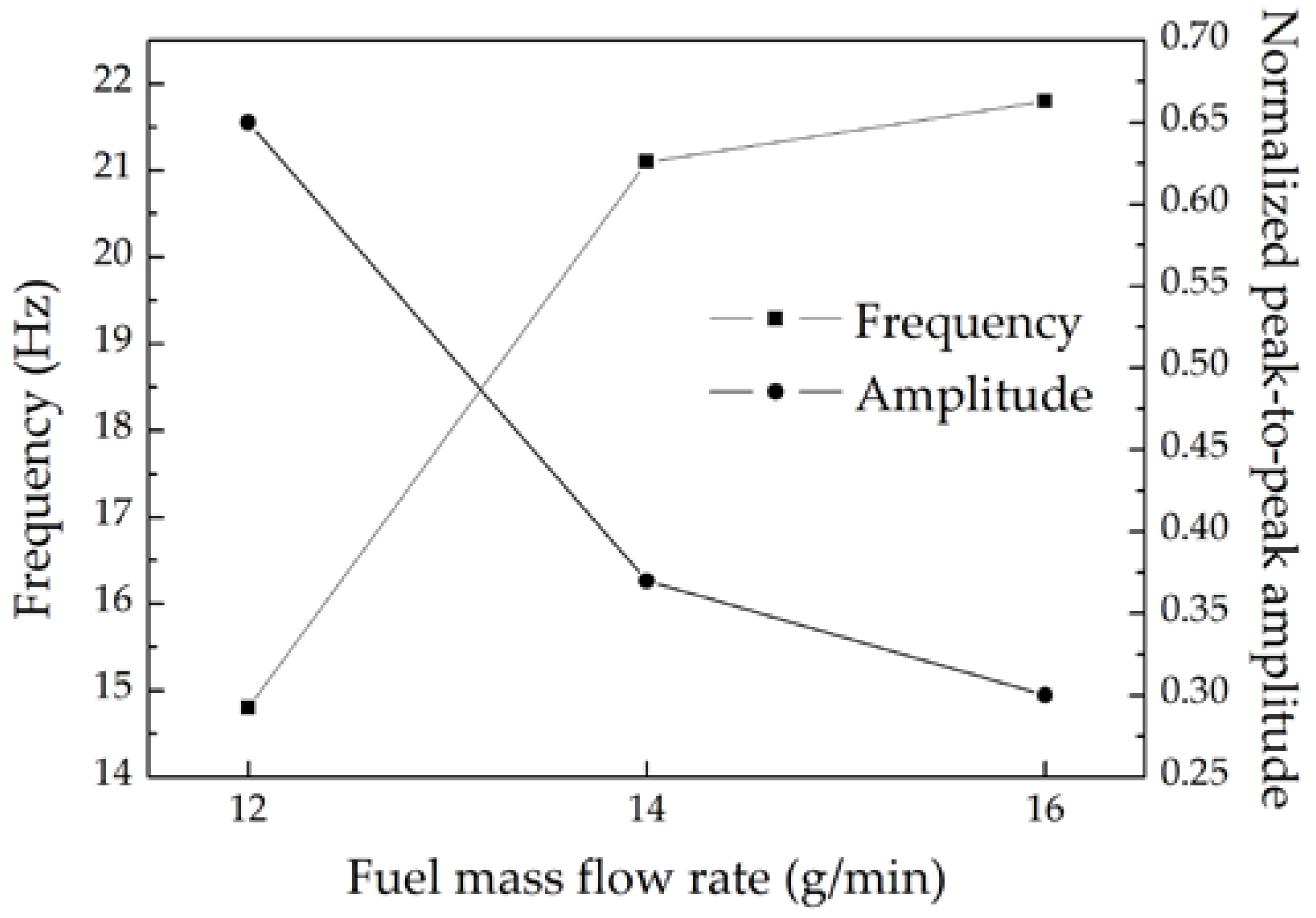
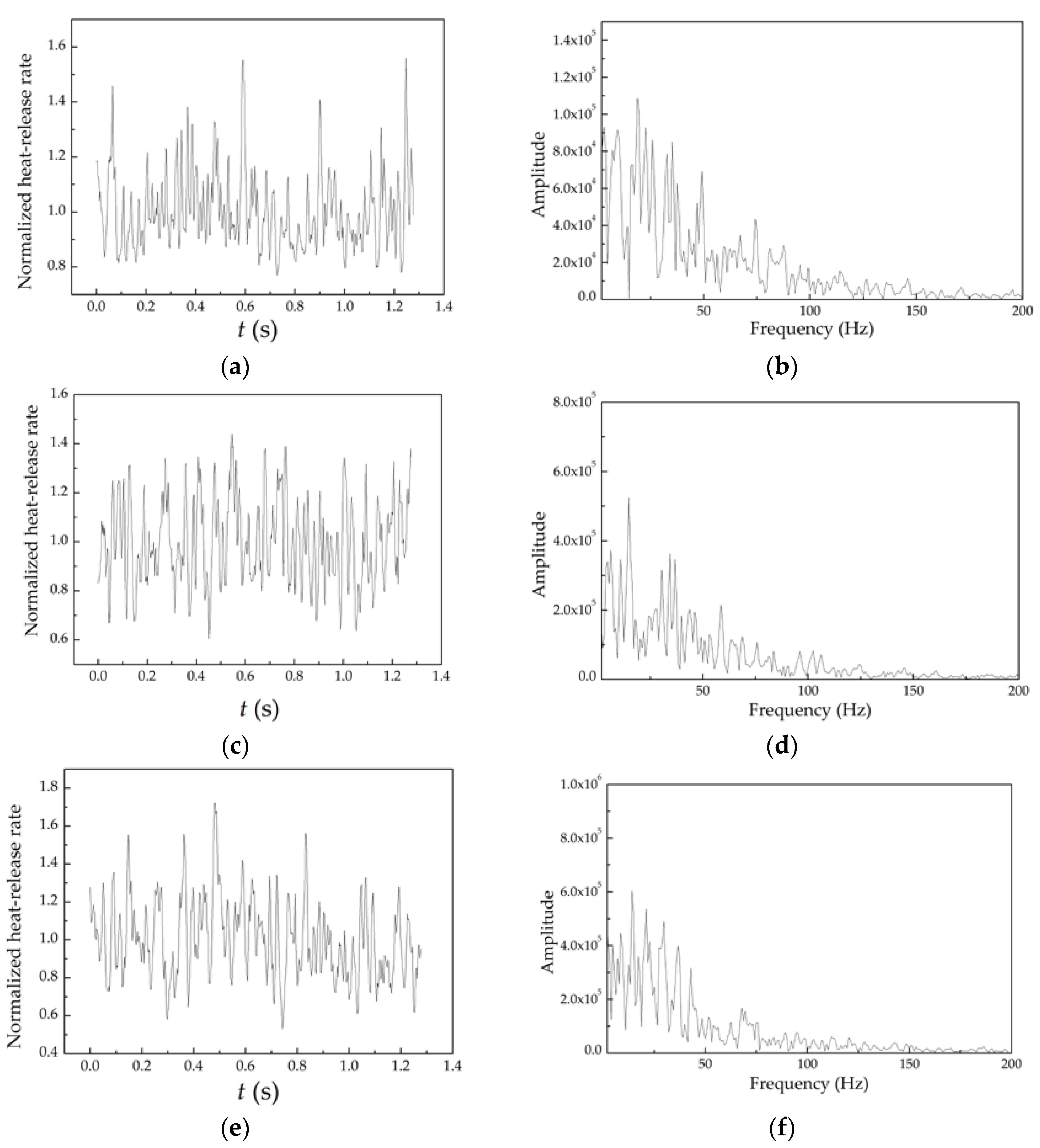


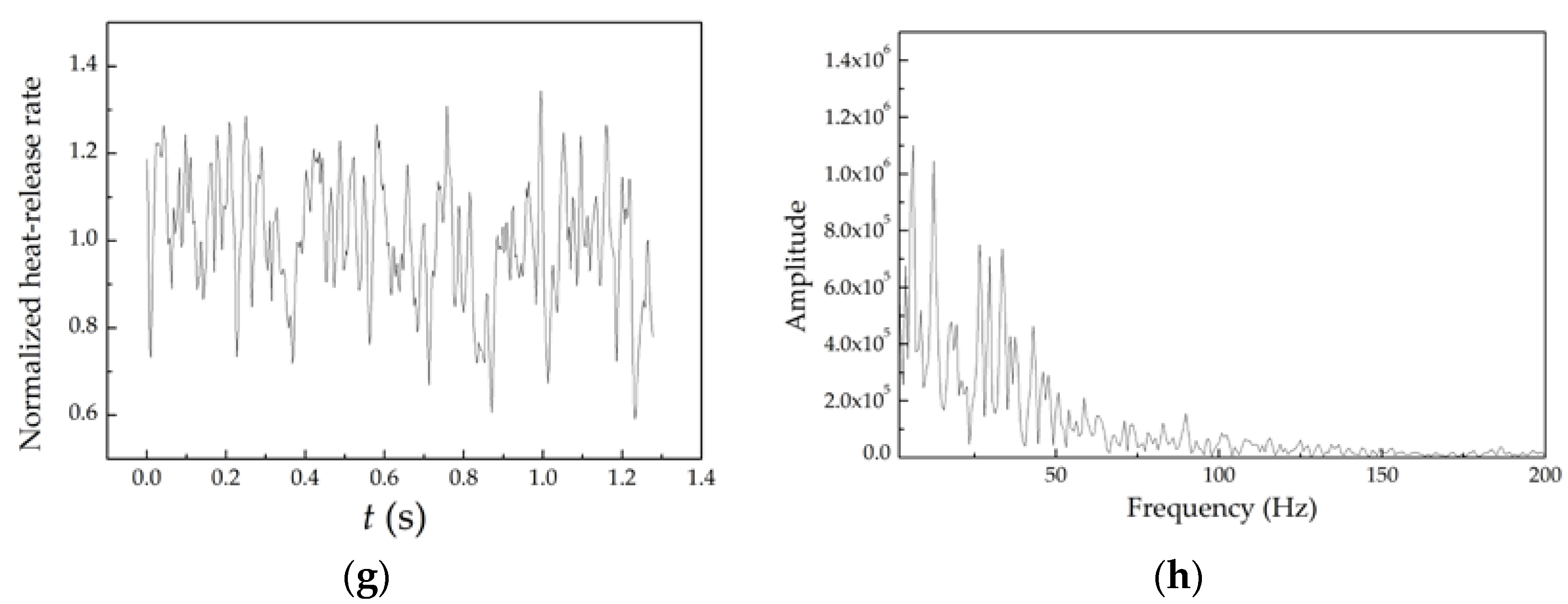
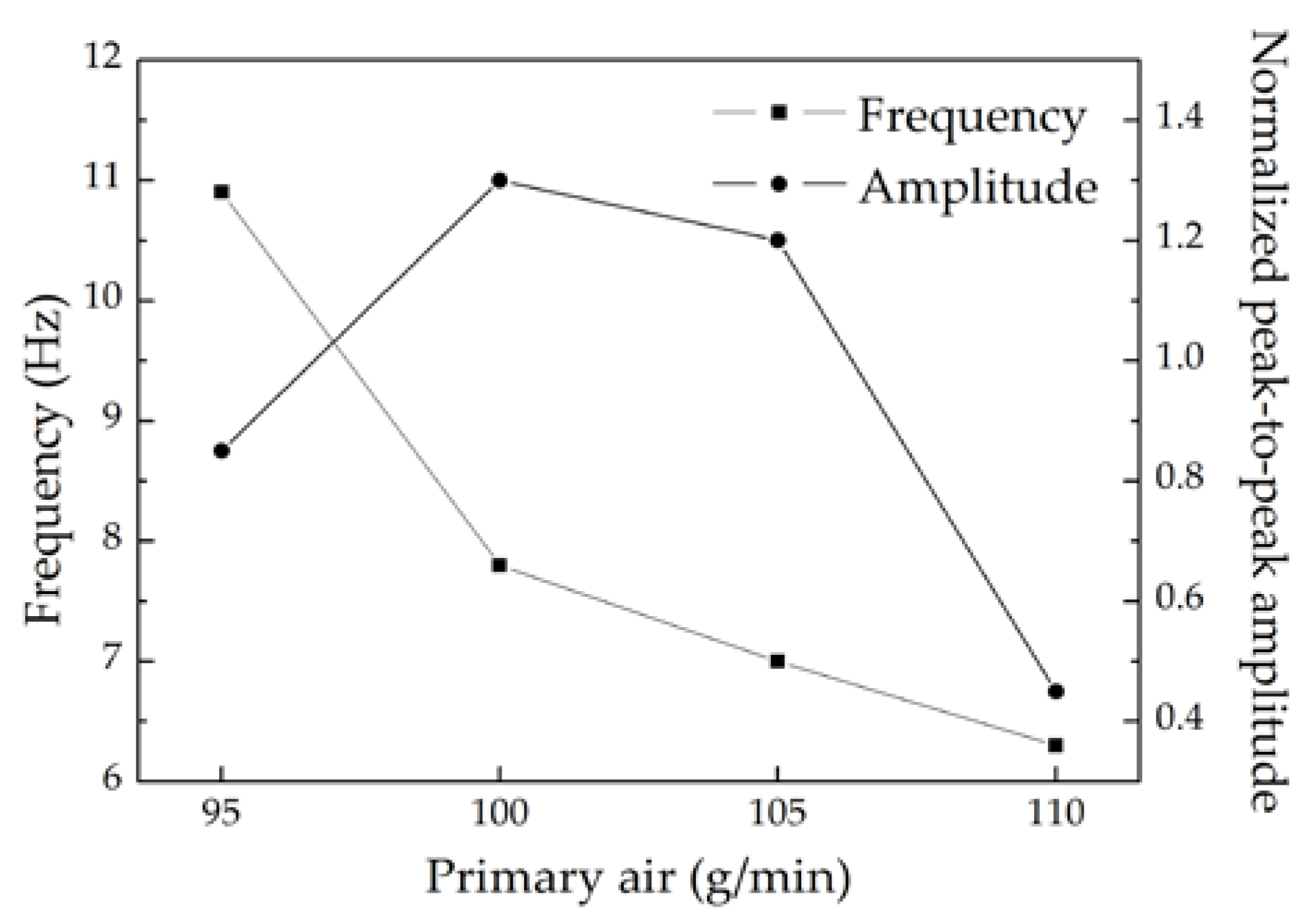
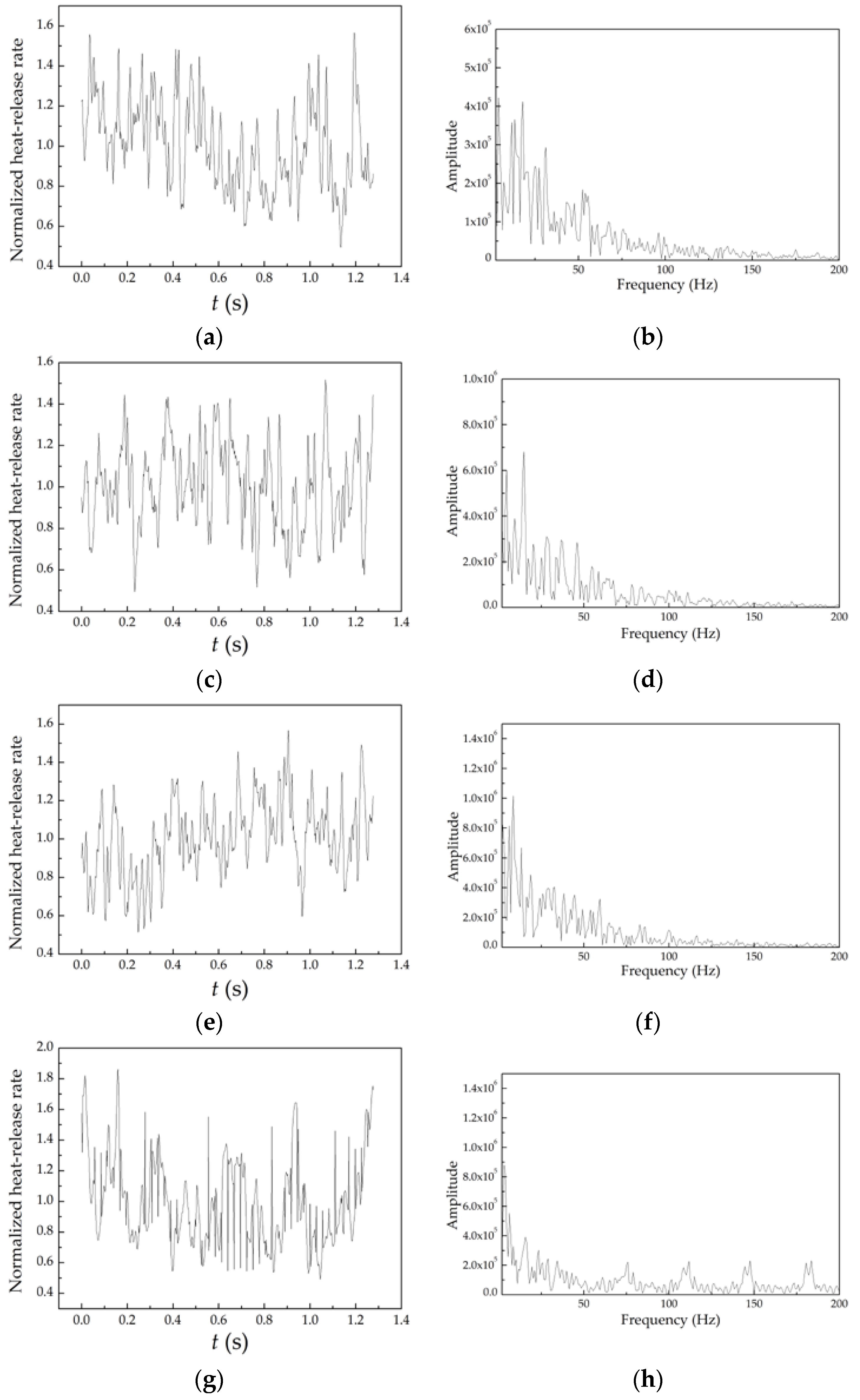
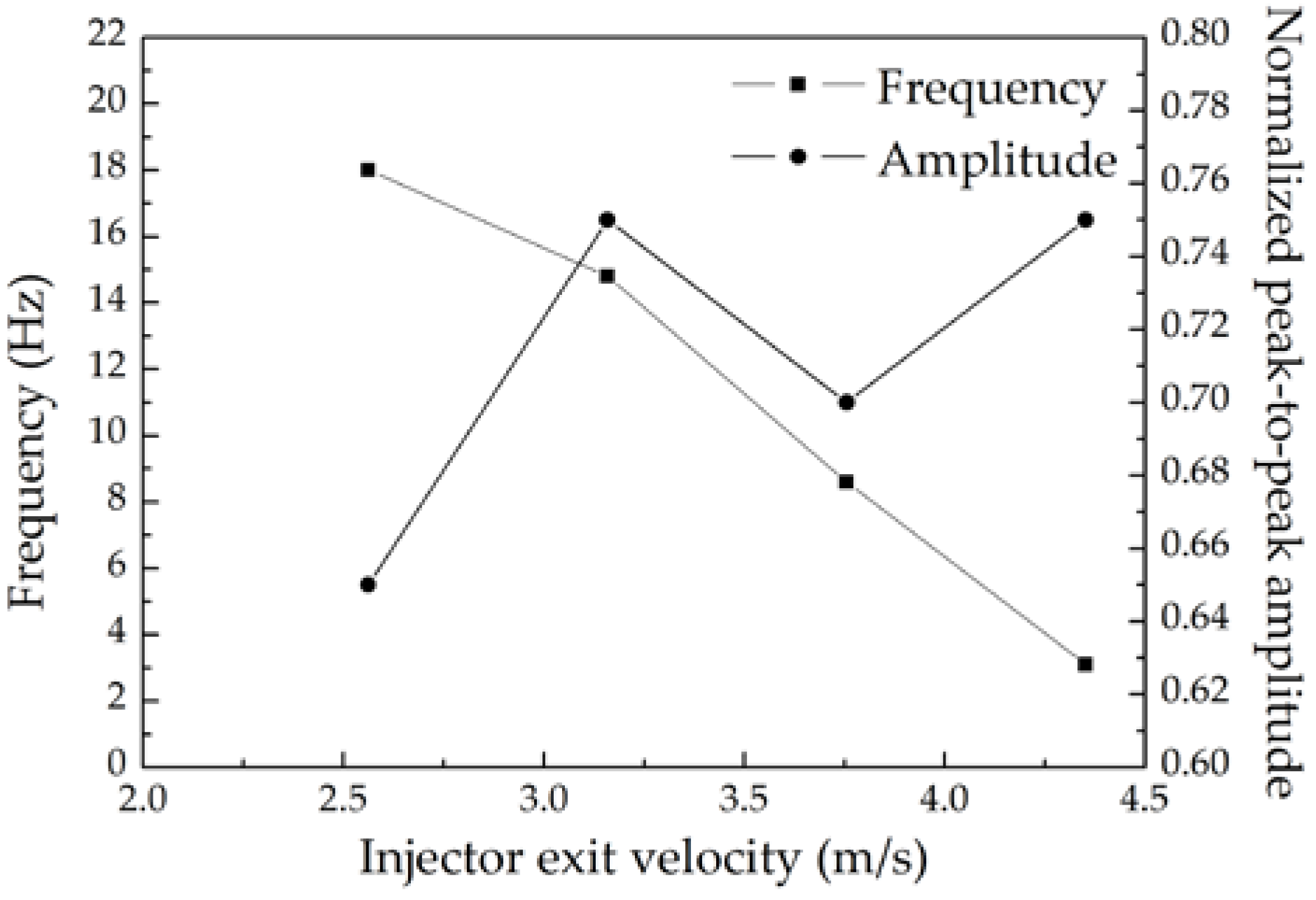

| Case | Combustor Pressure, P (bar) | Fuel Mass Flow Rate, ṁF (g/min) | Air Mass Flow Rate, ṁA (kg/min) | Primary Air, ṁpri (g/min) | Injector Exit velocity, ve (m/s) |
|---|---|---|---|---|---|
| 1 | 4 | 12 | 2.1 | 105 | 5.13 |
| 2 | 4 | 14 | 2.1 | 105 | 5.22 |
| 3 | 4 | 16 | 2.1 | 105 | 5.31 |
| 4 | 3 | 12 | 2.1 | 105 | 6.84 |
| 5 | 4 | 12 | 2.1 | 105 | 5.13 |
| 6 | 5 | 12 | 2.1 | 105 | 4.11 |
| 7 | 5 | 16 | 1.9 | 95 | 3.90 |
| 8 | 5 | 16 | 2.0 | 100 | 4.07 |
| 9 | 5 | 16 | 2.1 | 105 | 4.25 |
| 10 | 5 | 16 | 2.2 | 110 | 4.42 |
| 11 | 5 | 8 | 1.3 | 65 | 2.56 |
| 12 | 5 | 10 | 1.6 | 80 | 3.16 |
| 13 | 5 | 12 | 1.9 | 95 | 3.76 |
| 14 | 5 | 14 | 2.2 | 110 | 4.35 |
© 2018 by the authors. Licensee MDPI, Basel, Switzerland. This article is an open access article distributed under the terms and conditions of the Creative Commons Attribution (CC BY) license (http://creativecommons.org/licenses/by/4.0/).
Share and Cite
Xi, Z.; Fu, Z.; Hu, X.; Sabir, S.W.; Jiang, Y. An Experimental Investigation on Flame Pulsation for a Swirl Non-Premixed Combustion. Energies 2018, 11, 1757. https://doi.org/10.3390/en11071757
Xi Z, Fu Z, Hu X, Sabir SW, Jiang Y. An Experimental Investigation on Flame Pulsation for a Swirl Non-Premixed Combustion. Energies. 2018; 11(7):1757. https://doi.org/10.3390/en11071757
Chicago/Turabian StyleXi, Zhongya, Zhongguang Fu, Xiaotian Hu, Syed Waqas Sabir, and Yibo Jiang. 2018. "An Experimental Investigation on Flame Pulsation for a Swirl Non-Premixed Combustion" Energies 11, no. 7: 1757. https://doi.org/10.3390/en11071757





